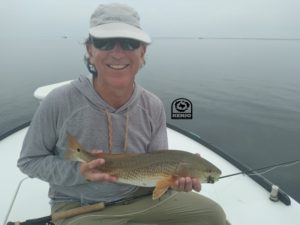How to fly cast gently.
One fly casting technique that proves itself very valuable in the saltwater world is learning how to lay down the fly and line gently. Producing gentle casts can mean great catching and less spooking of the fish you are stalking.
The real challenge though is performing these gentle casts while your eyeballs are popping out of your own head in your excitement! Staying calm and not rushing the cast produces more hookups than trying to rush and hitting the fish too hard.
Here in this clip you can see David does a great job maintaining his composure. This pod of redfish are tailing along the spartina grass edges. You can hear us whispering to each other as he makes 3 casts in order to get the crab fly in the right spot.
On such a calm day you can be sure those fish would have spooked had the fly been too heavy or if he had cast “down” at the fish. Communication on the skiff in the moment is also key to our success.
Landing the fly softly is achieved by aiming your casting loop about eye level above the fish. When presenting the fly, be a little more gentle on the final forward stroke.
To do this, stop the rod tip early in your forward cast. Leave it up a bit longer than usual as you let the weight of the fly line gently pull the rod down. It would go from the 1 or 2 o’clock position down in front to the horizontal position.
With a little routine practice, you can use your line hand to feather it all down slowly. This will help the fly line lay out straight and gentle. That way the fly lands right and softly. For those redfish, you want to be able to move the fly on the first strip. Then you will be able to set the hook properly. And that hungry redfish will then gulp down your crab fly. Fish on!
Book NOW with Capt Kenjo! Great weather is in the forecast!
